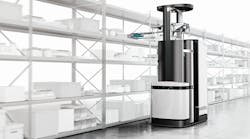In a previous article, we examined how distribution centers will need to change their picking processes to deal with a more diverse order profile in the new digital age. As customers continue the trend of only ordering what they need, digital orders are becoming more frequent with a smaller number of items. In response, wholesale orders are changing from pallet-sized orders to case-sized orders. This article will examine the available picking technologies that will help enable these new processes.
1. Picker-to-Item
Sending the picker to the items in the picking area is the traditional and most common method of picking. The material storage fixtures in the pick area range from rack shelving, pallet/case flow rack, and bin shelving. To utilize the cube of the distribution center with high ceilings, pick modules and mezzanines aid in picking the correct item and quantity for the order. Electronic solutions such as radio frequency scanners, pick-to-light and voice picking are the most popular technologies to assist the picker and have replaced the traditional paper pick lists.
Picker-to-item strategies are best used when the costs of labor and distribution center area are lower relative to using other technologies. Many pickers can be put into action to improve the throughput of the facility.
2. Item-to-Picker
The next step in picking technology are solutions that can bring the item directly to the picker. These technologies include carousels, mini-loads, automated storage and retrieval and mobile storage systems. Carousels are motorized bin shelving on rails that rotate the items stored on shelving to a picking station. Carousels include both horizontal and vertical direction and are sequenced to coordinate multiple carousels to improve picking throughput. Automatic storage and retrieval systems (ASRS) are an integrated set of lifts that transverse through storage racks, picking up containers and bringing them down to picking stations. The classis ASRS is for pallet storage and retrieval. When referring to case sizes or less-than cases, mini-loads are used. Another type of “item-to-picker” technology is mobile storage units. Similar to automated guided vehicles, they roll the storage device to a picking station highlighting the position on the shelf to pick the product from.
In most cases, these item-to-picker technologies are coordinated to keep items in front of the pickers to minimize picker wait time and maximize productivity. To achieve this, multiple sequenced pieces of technology are used, sometimes making the cost of the technology prohibitive for the productivity gains.
The main advantage for this type of technology to be deployed in distribution centers occurs in areas where labor rates are higher and/or floor space is expensive enough to justify the technology. The throughput restrictions of the technology typically means item-to-picker technologies will not work for higher volume items. Therefore, the technology must be reviewed with the order profile to justify the technology based on costs and throughput. For example, many smaller lower volume items can increase their storage density in a pick area when using an item-to-picker technology. For example, Amazon bought Kiva Systems’ (now known as Amazon Robotics) mobile storage units to own the technology for their smaller, lower volume items like books.
3. Put-to-Order Technology
Batch pick technologies have a solid foundation in digital distribution centers where web promotional items generate a spike in demand for a few items. These select items are weaved together to generate a large quantity to be picked in bulk and sent to the “put-to-order” system, which is then divided by order and combined with the other items of that order.
Put-to-order technologies range from highly mechanized unit sorters to simple pallet aitem picking warehouse
nd bin shelving (put-walls) to collect the multiple items being picked for an order. Many times the technology will use a light system that directs the associate to the order location to put a specific number of items in the outbound shipper. For high-volume facilities, a unit sorter, which is typically a tilt-tray, bombay or cross-belt type, is used to marry items from different pick zones across the facility. Middle volume facilities, with many stock keeping units (SKUs) which still have multiple pick zones, may use put-walls to combine the items from the multiple pick zones. Lower volume facilities may combine item-to-picker technologies with put-walls to capture all the items of the order.
4. Storage Technology to Compliment Picking
Digital distribution centers are laid out in a multitude of ways to aid the technology being used for picking. For picker-to-item technologies, pick modules were mentioned as storage means to utilize the cube of the facility. For high-volume items, very narrow aisle (VNA) storage should be used in conjunction with throw lines to peel off cases and send them to put-to-order technologies. For higher to middle-volume items, a pick module know as a “shave tower” can be used to move pallets of product to the tower so they can be picked to a conveyor line.
To utilize the cube of the facility when put-to-order technology is incorporated, mezzanines are used so both the upper and lower levels are being productive. Value-added services and packing stations may be positioned on one level while the put-to-order technology is being used on the other level.
Conclusion
Digital distribution center layouts are very unique depending on the order profile and the way orders are being waved. A wide variety of technologies are available to be used to achieve the most productive and effective ways to process digital orders. Considering the many advantages of these technologies, digital distribution professionals will be required to match the order profiles and waving methods with the appropriate layout of the technologies.
Richard Barnes, a principal consultant for WiPro Ltd., is a supply chain expert and master black belt with extensive leadership experience and a strong background in applying people, process and technology to streamline supply chain operations.










